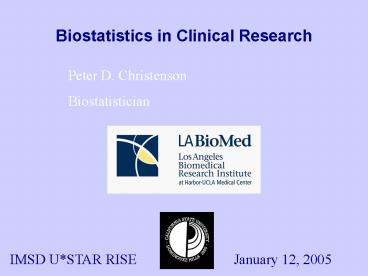Biostatistics in Clinical Research
1 / 19
Title:
Biostatistics in Clinical Research
Description:
Online Study Size / Power Calculator. Software Output: Power with N=100 Subjects/Group ... and Power to Detect Oatmeal Effect of 3 Points in Cholesterol ... –
Number of Views:98
Avg rating:3.0/5.0
Title: Biostatistics in Clinical Research
1
Biostatistics in Clinical Research
Peter D. Christenson Biostatistician
January 12, 2005
IMSD USTAR RISE
2
Outline
- Example
- Statistical Issues in Clinical Research
- Prospective vs. Retrospective Studies
- Size and Power of Clinical Research Studies
3
Example Statistical Issues
4
Statistical Aspects of Clinical Research
- Target population / sample / generalizability.
- Quantification of hypotheses, case definitions,
endpoints. - Control of bias confounding.
- Comparison/control group.
- Randomization, blinding.
- Justification of study size power, precision,
other. - Use of data from non-completers.
- Methods of analysis.
- Mid-study analyses.
5
Major Study Designs
- Prospective
- Follow subjects with specified characteristics
and measure outcome (e.g., disease) - Example compare cholesterol between oatmeal
eaters and non-eaters - Compare subjects with or w/o characteristic on
the outcome - Typical clinical trial
- Retrospective
- Find subjects with or w/o an outcome (e.g.,
disease), and measure their characteristics - Example compare oatmeal eating status between
high and low cholesterol subjects - Compare outcome groups on subject
characteristics - Typical case-control
6
Example Study Size for a Clinical Trial
- Consider a prospective study
- Randomize an equal number of subjects to
treatment A (no oatmeal) or treatment B
(oatmeal). - Follow all subjects for a month.
- Measure X pre-post change in cholesterol.
- Primary Study Aim Does oatmeal have an effect?
Do treatments A and B differ in mean X? - Our Goal How many subjects are needed to answer
the primary aim?
7
Extreme Outcome 1
Suppose results from the study are plotted as
X
Each point is a separate subject.
A
B
Obviously, B is more effective than A.
8
Extreme Outcome 2
Suppose results from the study are plotted as
X
Each point is a separate subject.
A
B
Obviously, A and B are equally effective.
9
More Realistic Possible Outcome I
Suppose results from the study are plotted as
Is the ? large enough to be clinically relevant?
X
Each point is a separate subject.
?
A
B
Is the overlap small enough to claim that B is
more effective?
10
More Realistic Possible Outcome II
Suppose the ranges are narrower, with the same
group mean difference
X
Each point is a separate subject.
?
Same ?, but subjects in each group are more alike.
A
B
Now, is this minor overlap sufficient to come to
a conclusion?
11
More Realistic Possible Outcome III
Suppose the ranges are wider, but so is the group
difference
X
Each point is a separate subject.
?
A
B
Is the overlap small enough to claim that B is
more effective?
12
More Realistic Possible Outcome IV
Here, the ranges for X are the same as the last
slide, but there are many more subjects
X
Each point is a separate subject.
A
B
So, just examining the overlap isnt sufficient
to come to a conclusion, since intuitively the
larger N should affect the results.
13
Factors for Study Size So Far
- The number of subjects itself N for each group.
- Mean difference between treatments that is
important. - Heterogeneity among subjects who are on the same
treatment. - What else?
14
Possible Errors in Study Conclusions
Truth
H0 No Effect
HA Effect
Study Claims
No Effect
Correct
Error (Type II)
Effect
Correct
Error (Type I)
Power Maximize
Minimize
15
Factors for Study Size Final
- The number of subjects itself N for each group.
- Mean difference between treatments that is
important. Clinical judgment. - Heterogeneity among subjects who are on the same
treatment. Need Std Dev from pilot study. - Power Probability of correctly claiming an
effect. Usually want 80. - Type I Error chance Probability of incorrectly
claiming an effect. Usually want 5. - The next figure illustrates the
inter-relationships among these factors.
16
Graphical Representation of Power
H0 true effect0 HA true effect3 Effect in
study1.13
N100 per Group Larger Ns give narrower curves
41
HA
H0
5
Effect (Group B mean Group A mean)
\\\ Probability of concluding HA if H0 is true.
/// Probability of concluding H0 if HA is true.
Power100-4159
Note greater power if larger N, and/or if true
effectgt3, and/or less subject heterogeneity.
17
www.stat.uiowa.edu/rlenth/Power
Online Study Size / Power Calculator
18
Software Output Power with N100 Subjects/Group
Pilot data SD9.603. Want to Detect 3 point
effect on cholesterol.
19
Number of Subjects and Power to Detect Oatmeal
Effect of 3 Points in Cholesterol
?3, SD9.603, PIncorrectly claim effect 0.05






























![[PDF] Statistical Topics in Health Economics and Outcomes Research (Chapman & Hall/CRC Biostatistics Series) 1st Edition, Kindle Edition Full](https://s3.amazonaws.com/images.powershow.com/10100154.th0.jpg?_=20240816062)
